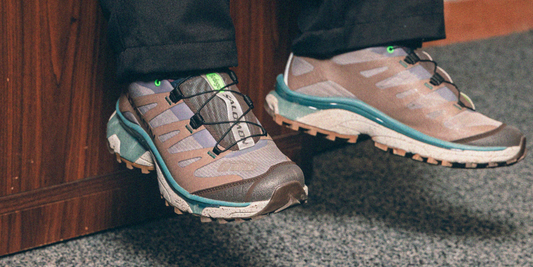Generally, there isn’t an amount of praise that can be heaped upon 2001: A Space Odyssey that would be considered excessive. For brevity’s sake, it will suffice to say that 2001 is universally acknowledged as one of the best and most influential films ever made. As such, 2001: A Space Odyssey is ripe for being mined as inspiration. While anyone is capable of making surface level callbacks to the movie’s recognizable moments, truly capturing the visionary spirit is another matter. For Fall/Winter 2018, influential pioneers Undercover have booked their boundary transcending aesthetic a seat on a Pan Am Orion III, with a collection that brings the fantastical futurism of 2001 to life.
The prescient vision of future offered by Stanley Kubrick prefigured multiple decades’ worth of technological advancements, and remains one of the most singularly realistic cinematic universes ever constructed, no mean feat for a speculative science fiction narrative. Meticulous would be too mundane a description to do full justice to the down to the last detail of world building. A critical factor in 2001’s realism is that instead of having Hollywood artists imagine what technology would become in 33 years, Kubrick engaged professionals from the aerospace field to push past the limits of existing, state of the art technology.
The same principles apply to the collection’s collaborative Converse All Star. The design of the Chuck Taylor has remained more or less unchanged for over a century. It isn’t just familiar; it’s iconic. A “futuristic” version of the shoe that added B-movie UFO silver and multicolored blinking lights would be kitsch. Complimenting the classic, canvas upper with tonal laces, a contrast toe bumper, and utilitarian ‘order’ ‘disorder’ text on the rubber toecaps creates a vision of a timeless design that seamlessly enters into 2001’s reality.
2001: A Space Odyssey isn’t just visually stunning. It is also intellectually captivating. Any successful visual interpretation would obviously have to account for the open ended philosophical issued posed. In other words, the feeling, not just the look must be down pat.
One of the most memorable sequences is the transition from the movie’s prehistoric section, where simian human ancestors, spurred on by the mysterious monolith, learn to use tools and walk upright for the first time, to the distant future. This plays out on the screen as the alpha male, tool-wielding ape throws a bone into the air, which comes down as a gracefully orbiting spacecraft, with Johann Strauss’s Blue Danube as musical accompaniment.
But as the plot unfolds, it becomes clear that the modern men of the space age are ultimately as clueless before the monolith as the prehistoric apes were. The technological glory of the year 2001 is just another tool that humanity has learned to wield, without any greater understanding of the mysterious forces that guided their collective hand.
Of course, the one reference that everyone, even people who have never watched all the way through, knows is the HAL9000 computer politely, but firmly informing Dave that he cannot open the pod bay doors. The feelings of being set adrift in a sea of technological creation that has outstripped its creator are echoed by the collection’s subversion of familiar forms.
By incorporating visual elements from this legendary cinematic work into their latest work, Undercover translates the futuristic aesthetic of and the ethereal undercurrent that runs throughout 2001: A Space Odyssey as a tangible, ready to wear quality, the perfect statement piece for an age in which losing an argument to a computer is a daily occurrence, and not a futuristic fantasy.



























